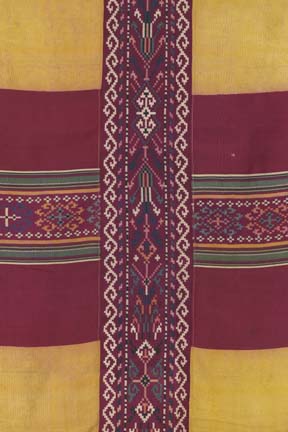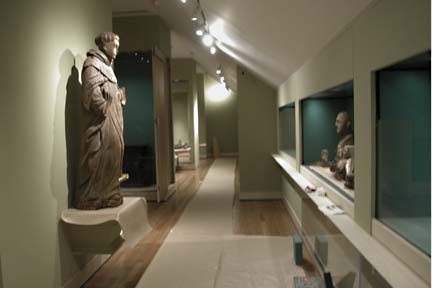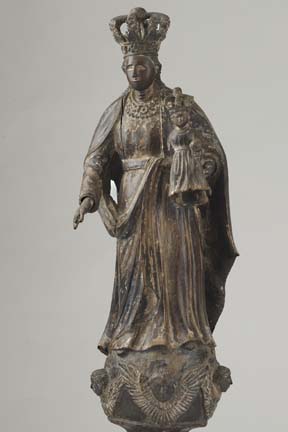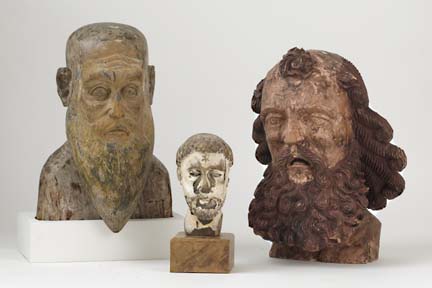
[ MAUKA MAKAI ]
COURTESY OF THE HONOLULU ACADEMY OF ARTS
George Ellis admires the wood sculpture of St. Thomas Aquinas housed in the new Filipino gallery at the Honolulu Academy of Arts that is named after Ellis.
Enriching the
CommunityThe Honolulu Academy
of Arts opens a permanent
Filipino art collection
THE PURSUIT of beauty is a fundamental expression of humanity. All through history and in every culture, amid the struggles of survival, people have created things of beauty: Art.
Our universal appreciation for beauty empowers art with the ability to convey the richness of the culture that creates it. Through "David" and the Sistine Chapel, for instance, we can appreciate the creative powers of Michelangelo and the glorious artistic traditions of Italy.
Art of the Philippines:
Where: The Honolulu Academy of Arts, 900 S. Beretania St.
The George and
Nancy Ellis Gallery
Hours: 10 a.m. to 4:30 p.m. Tuesdays to Saturdays and 1 to 5 p.m. Sundays
Admission: $7 general; $4 students, seniors and military; free to children 12 and under
Call: 532-8700
Last week, Hawaii's appreciation of its Filipino community was enriched when the Honolulu Academy of Arts opened the doors to Art of the Philippines: The George and Nancy Ellis Gallery. The gallery houses the only permanent Filipino art exhibit in the United States.
"Filipinos have had very little cultural visibility. Maybe this is a good start," says Jovita Zimmerman, founder of the Association of Filipino University Women.
She was also instrumental in organizing the academy's annual Filipino Christmas celebration, Pasko!
Zimmerman, a Philippine native who married an American, donated her personal antiques collection to the academy for the exhibit, which is divided into three areas of study: Pre-Western contact Philippines, the Spanish Colonial period and the indigenous arts of the Northern and Southern Philippines.
"Carl (her husband) and I had a discussion with our children, and we thought it was best not to divide the pieces," she says. "We saw the Honolulu Academy of Arts as a home for the collection."
COURTESY OF THE HONOLULU ACADEMY OF ARTS
A silk tube skirt by the Tausug people of the Sulu Archipelago.
Zimmerman's donation represents "the Spanish colonial years and the American colonial years." Pieces include Spanish-style furniture and Muslim Filipino art from Mindanao such as textiles and brass pieces. The collection even includes her sister's French lace, 1930s wedding dress.
"You know, every colonizer tries to keep the colonized from their own culture, and we began to look at our own locally made items as 'low class,'" Zimmerman said. "My sister's wedding dress should have been a Filipino-made item. But it had to be imported. That dress is an item from the American colonization."
Unfortunately, feelings of ethnic inferiority were reinforced when Filipinos crossed the ocean and immigrated to Hawaii, where they were looked down upon for many years. Zimmerman calls it "the plantation mentality."
"I want our children (in Hawaii) to know about this culture. I see local-born children, when asked what their ethnic make-up is, list Filipino last. They still suffer from that plantation-mentality complex," she says.
"The reason we gave everything we could give that was worth anything was to make young Filipinos realize they have a lot to be proud of, to look at their culture and learn to appreciate it."
COURTESY OF THE HONOLULU ACADEMY OF ARTS
A beaded bag from Mindanao Island is made of Abaca, cotton, glass beads and copper.
IF FILIPINO YOUTH in Hawaii could look at the matter through the eyes of George Ellis, Zimmerman would have no more worries. It was primarily through the devotion and commitment of the academy's former director that the Filipino gallery has come to grace the museum.
Ellis was introduced to art of the Philippines during graduate school at UCLA when he was a research assistant at the Fowler Museum of Cultural History. He became interested in the art of Northern Luzon and discovered that there was very little information written about Filipino art. From that point on, a passion was ignited that continued throughout Ellis' career.
In 1981, while still working in Los Angeles, Ellis put together a major national exhibit called "People and Art of the Philippines" that toured California, Chicago and Hawaii, and produced a 300-page accompanying catalogue that continues to inform scholars today.
When Ellis wound up in Hawaii shortly after the show as director of the academy, he said he "brought Filipino material with me to build the collection here." Through the years, Ellis continued to grow the academy's collection. Five years ago, the academy began a project to renovate and build new galleries for its Asian and Pacific collections. The Philippine gallery completes that project.
"We've finally fulfilled Mrs. Cooke's dream of displaying art that reflects the ethnic composition of Hawaii," Ellis says. (The academy was founded by Anna Rice Cooke.)
COURTESY OF THE HONOLULU ACADEMY OF ARTS
Jewelry and clothing ornaments from the 12th to 15th centuries.
THE PERMANENT EXHIBIT is almost completely historical. It displays indigenous works from pre-Western contact Philippines, Northern Luzon and Mindanao, and the Spanish Colonial religious art of other regions.
"We'll never know the full extent of the kind of art the Philippines produced before (Ferdinand) Magellan came," Ellis says of the Spanish explorer's 16th century arrival in the Philippines, which began Spain's 350-year colonial reign. "At that point, the whole country became Roman Catholic, and Christian imagery replaced all indigenous art forms."
Northern Luzon, Mindanao and the Sulu Archipelago were among the few pockets in the country that remained unaffected by Spanish rule, since many of these areas were protected by rugged terrain inaccessible to the Spaniards.
The academy's indigenous Filipino art includes items such as basketry, wooden containers, textiles, adornments, grave markers, weapons and carved spoons. Its Spanish Colonial collection includes sculptures of the Virgin Mary, St. Thomas Aquinas, a retablo, or altarpiece of the Holy Family, and a large Madonna.
Ellis says any works by modern Filipino artists, save one by the renowned sculptor Alfonso A. Ossorio, would be shown in the academy's contemporary gallery rather than his namesake space.
"If you looked at the work of five artists today, you wouldn't be able to tell what country anyone was from just by looking at it," Ellis says. "And that's the point we're trying to make with Ossorio."
COURTESY OF THE HONOLULU ACADEMY OF ARTS
A tube skirt comes from Mindanao.
THE ZIMMERMANS claim that the only reason the academy has a Filipino gallery at all is due to Ellis.
"It was only through his influence that it was done," says Carl Zimmerman. "It's really a gorgeous thing, and I'm sure it will gather a lot of attention in art circles outside of Hawaii."
Jovita Zimmerman, of course, is more concerned with the circles inside her community.
"To me, my country is very important; I was raised that way. I look at my children, and they are American. I dragged my children to all kinds of Filipino events. Maybe that turned them off. Now, I worry about my grandkids. I want them to know they're part Filipino, not just American."
The George and Nancy Ellis Gallery hasn't any greater mission to accomplish than that.
COURTESY OF THE HONOLULU ACADEMY OF ARTS
A shot of Art of the Philippines: The George and Nancy Ellis Gallery.
COURTESY OF THE HONOLULU ACADEMY OF ARTS
A vibrant silk sash is a tapestry weave from the Sulu Archipelago.
COURTESY OF THE HONOLULU ACADEMY OF ARTS
"Madonna and Child," is a 19th century wood statue.
COURTESY OF THE HONOLULU ACADEMY OF ARTS
Busts of, from left, St. Paul, the founder of the Dominican order and St. Peter. All works are from the Philippines' Spanish Colonial Period.
Click for online
calendars and events.










